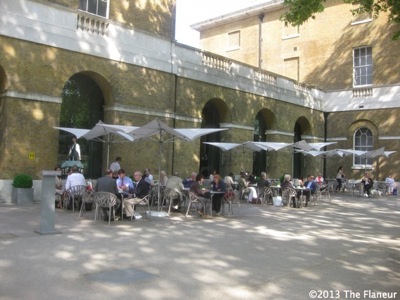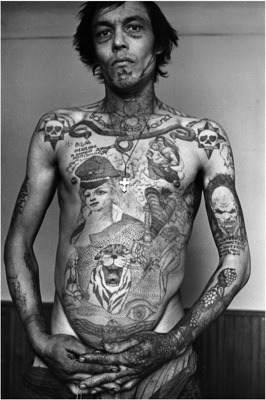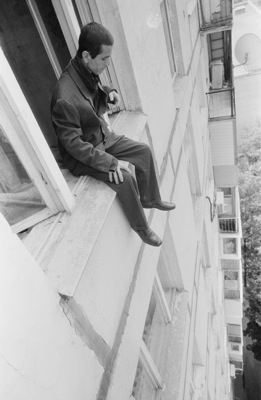
The Saatchi Gallery’s outdoor cafe is a great place to while away a warm summer’s afternoon in central London. But it does also have an impressive 70,000 square-foot complex of galleries that are worth a visit if you can tear yourself away from the sunshine.

For a few more days – until 9th June – the Saatchi is showing New Art from Russia, under the painful title Gaiety is the most outstanding feature of the Soviet Union. Not according to the evidence inside the gallery it isn’t. Stalin may have regarded gaiety as a feature of the USSR, but for those outside the Politburo life was very different. Sergei Vasiliev’s threatening pictures greet the visitor in gallery 1. A prison guard, he has documented the prison-made tattoos of the inmates.

Sergei Vasiliev, Russian Criminal Tattoo Encyclopedia Print No.12 © Sergei Vasiliev, 2010 Image courtesy of the Saatchi Gallery
These amateur designs are created unhygienically and include covert messages against the Soviet authorities. These images were taken between 1989 and 1993, all these men are now twenty years older – if they are still alive. Vasiliev was working for the KGB, which gives a further twist to the photos, which are displayed in large 165x122cm prints along the walls, giving the viewer a sense of looking into different cells and seeing the person incarcerated. Not much gaiety here.
Gallery 2 has more formal works, recalling Russian Constructivism. Yelena Popova’s pale, abstract works appear to be precariously balanced on bits of wood and doorhandles. But they are attached more thoroughly than they appear, controlled by secret means, like the Soviet population. Gosha Ostretsov’s wounded deer is ugly and utilitarian, a Lada rather than a Western gazelle. Even so, the deer has had to be finished off by hand, mended with a new skull. There is a reflection of a society in need, making do and unable to live as it wishes.

Vikenti Nilin From the Neighbours Series © Vikenti Nilin, 1993, Image courtesy of the Saatchi Gallery
Vikenti Nilin has photographed normal people doing something very unusual. All are sitting on the edge of their tower block windows. The desperation is quite clear and there is no hiding the realisation that many people must have lent forward slightly and taken the plunge. Some hold on, some just sit, death only a muscle spasm away. They are not driven to contemplate suicide by a brief fit of despair, but rather by a mind-numbing, continual desperation. Unpleasant and unhopeful, like Daniel Bragin’s Lady, a black PVC mess which reclines on the floor, looking like a murder victim.
By now I was hoping for something to lift the mood. Janis Avotin’s disappearing portraits weren’t the thing. Thinly painted canvases of fragile images that seem to be too overwhelmed to even exist. The sense of a life sketchily existing for a moment and then disappearing continues the bleak theme of Nilin’s photographs in the previous gallery.

Boris Mikhailov Case History 1997-1998 © Boris Mikhailov, 1998 Image courtesy of the Saatchi Gallery
Boris Mikhailov fills a room with images of the unloved Soviet underclass. Homeless, failed by Perestroika and capitalism these people show the daily suffering caused by political upheaval. Whether showing the close-up scar of a badly stitched wound next to a nipple or the general deformed, naked hopelessness of the forgotten, these images are pervaded by despair and desperation. Gaiety left these people’s lives a long, long time ago.
It is left to Liudmila Konstantinova to bring a note of humour to the exhibition. Her Paintings for holes, are merely 18 monochromatic canvases, hung in a manner that recalls Malevich and constructivism. But her interior decorating palette is wide, and the title suggests the twist to the piece. These works are made so that people can hide holes and cracks on their walls. An oblique and amusing way of looking at he same issues of poverty that the rest of the show examines more directly.
Saatchi Gallery
Duke Of York’s HQ,
King’s Road,
London,
SW3 4RY
This show ends on the 9th June

Leave a Reply